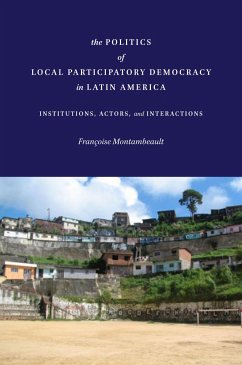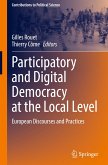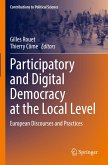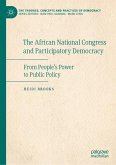Françoise Montambeault
The Politics of Local Participatory Democracy in Latin America
Institutions, Actors, and Interactions
Françoise Montambeault
The Politics of Local Participatory Democracy in Latin America
Institutions, Actors, and Interactions
- Gebundenes Buch
- Merkliste
- Auf die Merkliste
- Bewerten Bewerten
- Teilen
- Produkt teilen
- Produkterinnerung
- Produkterinnerung
Fran¿se Montambeault is Assistant Professor of Political Science at the Universit¿e Montr¿.
Andere Kunden interessierten sich auch für
![Participatory and Digital Democracy at the Local Level Participatory and Digital Democracy at the Local Level]() Participatory and Digital Democracy at the Local Level149,79 €
Participatory and Digital Democracy at the Local Level149,79 €![Human Rights and Participatory Politics in Southeast Asia Human Rights and Participatory Politics in Southeast Asia]() Catherine RenshawHuman Rights and Participatory Politics in Southeast Asia84,99 €
Catherine RenshawHuman Rights and Participatory Politics in Southeast Asia84,99 €![Participatory and Digital Democracy at the Local Level Participatory and Digital Democracy at the Local Level]() Participatory and Digital Democracy at the Local Level108,99 €
Participatory and Digital Democracy at the Local Level108,99 €![Cities, Business, and the Politics of Urban Violence in Latin America Cities, Business, and the Politics of Urban Violence in Latin America]() Eduardo MoncadaCities, Business, and the Politics of Urban Violence in Latin America86,99 €
Eduardo MoncadaCities, Business, and the Politics of Urban Violence in Latin America86,99 €![The African National Congress and Participatory Democracy The African National Congress and Participatory Democracy]() Heidi BrooksThe African National Congress and Participatory Democracy66,99 €
Heidi BrooksThe African National Congress and Participatory Democracy66,99 €![The Unfinished Transition to Democracy in Latin America The Unfinished Transition to Democracy in Latin America]() Juan Carlos Calleros-AlarcónThe Unfinished Transition to Democracy in Latin America196,99 €
Juan Carlos Calleros-AlarcónThe Unfinished Transition to Democracy in Latin America196,99 €![The State of Democracy in Latin America The State of Democracy in Latin America]() Jonathan R BartonThe State of Democracy in Latin America57,99 €
Jonathan R BartonThe State of Democracy in Latin America57,99 €-
-
-
Fran¿se Montambeault is Assistant Professor of Political Science at the Universit¿e Montr¿.
Hinweis: Dieser Artikel kann nur an eine deutsche Lieferadresse ausgeliefert werden.
Hinweis: Dieser Artikel kann nur an eine deutsche Lieferadresse ausgeliefert werden.
Produktdetails
- Produktdetails
- Verlag: Stanford University Press
- Seitenzahl: 288
- Erscheinungstermin: 14. Oktober 2015
- Englisch
- Abmessung: 236mm x 156mm x 25mm
- Gewicht: 550g
- ISBN-13: 9780804795166
- ISBN-10: 0804795169
- Artikelnr.: 42794067
- Herstellerkennzeichnung
- Libri GmbH
- Europaallee 1
- 36244 Bad Hersfeld
- gpsr@libri.de
- Verlag: Stanford University Press
- Seitenzahl: 288
- Erscheinungstermin: 14. Oktober 2015
- Englisch
- Abmessung: 236mm x 156mm x 25mm
- Gewicht: 550g
- ISBN-13: 9780804795166
- ISBN-10: 0804795169
- Artikelnr.: 42794067
- Herstellerkennzeichnung
- Libri GmbH
- Europaallee 1
- 36244 Bad Hersfeld
- gpsr@libri.de
Françoise Montambeault is Assistant Professor of Political Science at the Université de Montréal.
Contents and Abstracts
1Introduction
chapter abstract
The Introduction sets up the theoretical and empirical puzzles of the book.
In Mexico and Brazil, participatory democracy reforms have been implemented
as part of an emerging democratizing discourse among political parties to
which citizen participation was central. In practice, however, these
reforms have had mixed results, between countries and also between
municipalities within a single country, as in the case of Mexico and
Brazil. How do we explain success? And more important, how do we define
success? The Introduction poses the debate around these two questions,
presenting the theoretical arguments developed and the novel comparative
method used to empirically demonstrate these arguments.
2How Does Success Vary? Redefining Democratic Success
chapter abstract
Chapter 2 makes the case for a redefinition of the democratic success of
local participatory democracy, determined by the nature of the
state-society relationships that develop through formal and informal
participatory interactions. The chapter presents a typology to account for
variation along the two defining dimensions of state-society relationships:
the nature of mobilization (from individual to collective forms) and the
level of autonomy of the participants (from controlled to autonomous). It
defines the four ideal types used throughout the book to categorize the
diversity of empirical outcomes observed across cases: clientelism,
disempowering cooption, fragmented inclusion, and democratic cooperation.
3Why Do Cases Vary? A Comparative Approach
chapter abstract
Chapter 3 presents the four cities selected in greater detail, exploring
existing explanations for variations in success by emphasizing the cases'
historical and institutional similarities. It offers a framework for
explaining the various state-society relationship outcomes; defining the
indicators for a series of cultural, institutional, and agency-related
factors that, combined and in interaction with one another, can explain
variation along both the mobilization and the autonomy dimensions of
state-society relationships across and within cases.
4Ciudad Nezahualcóyotl: Participatory Democracy or Clientelistic
Participation?
chapter abstract
Chapter 4 shows that the case of participatory planning in Nezahualcóyotl
closely corresponds to the ideal type of clientelism. The persistence of
this traditional type of state-society relationship in the city despite the
existence of formal participatory channels is explained by two factors.
First, a tendency of institutional design to encourage individual and
particularistic forms of mobilization is observed. Second, the local
sociopolitical context-characterized by high political competition among
and within parties and an imbalance of civil society organizations engaged
in the process that maintain unequal understanding of state and society
actors' roles in the process-contributes to maintenance of control
strategies in participatory mechanisms that, in turn, undermine the
autonomy of civil society participants.
5León: Participation as Fragmented Inclusion
chapter abstract
Chapter 5 shows that the case of participatory planning in León corresponds
to the ideal type of fragmented inclusion. The development of such a
relationship is explained by two main elements. First, the case points to a
tendency of the chosen institutional design to encourage individual forms
of mobilization, organized around particularistic demands. Second, the
sociopolitical context characterized by a relatively stable situation of
political competition among and within parties and by participation of all
sectors of civil society tends to encourage development of a partnership
understanding of the state's and society's roles in the participatory
process and to minimize the use of control strategies and open up
possibilities for increased autonomy among participants.
6Recife: From Clientelism to Disempowering Co-option
chapter abstract
Chapter 6 moves the analysis to the case of Recife, in Brazil. This city
presents two cases in one, and as such allows a unique time-based
comparison that adds to the space-based comparisons undertaken throughout
the book. The chapter shows that Recife's two distinct experiences of
participatory budgeting, implemented under different local governments,
reveal contrasting patterns of state-society relationships: the first one
(1993-2000 under a PMDB/PFL coalition) closely corresponds to an ideal type
of clientelism, while the other one (2001-2009, under the PT) has the
characteristics of disempowering co-option. These varying outcomes thus
represent a variation on the mobilization axis, which is best explained by
the important changes introduced in the institutional design by the PT in
2001. The sociopolitical context, however, sustained an unequal partnership
and political control practices in both experiences.
7Belo Horizonte: The Route Toward Democratic Cooperation?
chapter abstract
Chapter 7 presents the most successful case, Belo Horizonte, showing how it
more closely corresponds to a case of democratic success, with democratic
cooperation emerging between state and society actors. This is best
explained by two main elements. On the one hand, the institutional design
adopted in Belo Horizonte fostered collective organization of groups of
citizens to define the common good. On the other hand, the sociopolitical
context within which the process was implemented fostered the autonomy of
participants and, rather than sustain strategies of political control, led
to development of an equal partnership (understood as such) between state
and society actors in the participatory process.
8Conclusion: Comparative Lessons for Participatory Democracy Theory
chapter abstract
Chapter 8 places the conclusions in a comparative perspective, highlighting
the theoretical and policy lessons that can be learned from the five
empirical cases presented in the book. It then explores the differentiated
consequences each type has for the deepening of local democratic practices
in governance processes, highlighting the limits and potential of each
model as well as discussing the implications for the quality of democracy
and its procedures, processes, and policy outcomes. The chapter discusses
the theoretical implications of the findings for the study of institutional
reform, civic engagement, and democratization, and also the policy
implications for the policy makers and politicians who lead such types of
participatory democracy reforms throughout Latin America, as well as in
municipalities around the world.
1Introduction
chapter abstract
The Introduction sets up the theoretical and empirical puzzles of the book.
In Mexico and Brazil, participatory democracy reforms have been implemented
as part of an emerging democratizing discourse among political parties to
which citizen participation was central. In practice, however, these
reforms have had mixed results, between countries and also between
municipalities within a single country, as in the case of Mexico and
Brazil. How do we explain success? And more important, how do we define
success? The Introduction poses the debate around these two questions,
presenting the theoretical arguments developed and the novel comparative
method used to empirically demonstrate these arguments.
2How Does Success Vary? Redefining Democratic Success
chapter abstract
Chapter 2 makes the case for a redefinition of the democratic success of
local participatory democracy, determined by the nature of the
state-society relationships that develop through formal and informal
participatory interactions. The chapter presents a typology to account for
variation along the two defining dimensions of state-society relationships:
the nature of mobilization (from individual to collective forms) and the
level of autonomy of the participants (from controlled to autonomous). It
defines the four ideal types used throughout the book to categorize the
diversity of empirical outcomes observed across cases: clientelism,
disempowering cooption, fragmented inclusion, and democratic cooperation.
3Why Do Cases Vary? A Comparative Approach
chapter abstract
Chapter 3 presents the four cities selected in greater detail, exploring
existing explanations for variations in success by emphasizing the cases'
historical and institutional similarities. It offers a framework for
explaining the various state-society relationship outcomes; defining the
indicators for a series of cultural, institutional, and agency-related
factors that, combined and in interaction with one another, can explain
variation along both the mobilization and the autonomy dimensions of
state-society relationships across and within cases.
4Ciudad Nezahualcóyotl: Participatory Democracy or Clientelistic
Participation?
chapter abstract
Chapter 4 shows that the case of participatory planning in Nezahualcóyotl
closely corresponds to the ideal type of clientelism. The persistence of
this traditional type of state-society relationship in the city despite the
existence of formal participatory channels is explained by two factors.
First, a tendency of institutional design to encourage individual and
particularistic forms of mobilization is observed. Second, the local
sociopolitical context-characterized by high political competition among
and within parties and an imbalance of civil society organizations engaged
in the process that maintain unequal understanding of state and society
actors' roles in the process-contributes to maintenance of control
strategies in participatory mechanisms that, in turn, undermine the
autonomy of civil society participants.
5León: Participation as Fragmented Inclusion
chapter abstract
Chapter 5 shows that the case of participatory planning in León corresponds
to the ideal type of fragmented inclusion. The development of such a
relationship is explained by two main elements. First, the case points to a
tendency of the chosen institutional design to encourage individual forms
of mobilization, organized around particularistic demands. Second, the
sociopolitical context characterized by a relatively stable situation of
political competition among and within parties and by participation of all
sectors of civil society tends to encourage development of a partnership
understanding of the state's and society's roles in the participatory
process and to minimize the use of control strategies and open up
possibilities for increased autonomy among participants.
6Recife: From Clientelism to Disempowering Co-option
chapter abstract
Chapter 6 moves the analysis to the case of Recife, in Brazil. This city
presents two cases in one, and as such allows a unique time-based
comparison that adds to the space-based comparisons undertaken throughout
the book. The chapter shows that Recife's two distinct experiences of
participatory budgeting, implemented under different local governments,
reveal contrasting patterns of state-society relationships: the first one
(1993-2000 under a PMDB/PFL coalition) closely corresponds to an ideal type
of clientelism, while the other one (2001-2009, under the PT) has the
characteristics of disempowering co-option. These varying outcomes thus
represent a variation on the mobilization axis, which is best explained by
the important changes introduced in the institutional design by the PT in
2001. The sociopolitical context, however, sustained an unequal partnership
and political control practices in both experiences.
7Belo Horizonte: The Route Toward Democratic Cooperation?
chapter abstract
Chapter 7 presents the most successful case, Belo Horizonte, showing how it
more closely corresponds to a case of democratic success, with democratic
cooperation emerging between state and society actors. This is best
explained by two main elements. On the one hand, the institutional design
adopted in Belo Horizonte fostered collective organization of groups of
citizens to define the common good. On the other hand, the sociopolitical
context within which the process was implemented fostered the autonomy of
participants and, rather than sustain strategies of political control, led
to development of an equal partnership (understood as such) between state
and society actors in the participatory process.
8Conclusion: Comparative Lessons for Participatory Democracy Theory
chapter abstract
Chapter 8 places the conclusions in a comparative perspective, highlighting
the theoretical and policy lessons that can be learned from the five
empirical cases presented in the book. It then explores the differentiated
consequences each type has for the deepening of local democratic practices
in governance processes, highlighting the limits and potential of each
model as well as discussing the implications for the quality of democracy
and its procedures, processes, and policy outcomes. The chapter discusses
the theoretical implications of the findings for the study of institutional
reform, civic engagement, and democratization, and also the policy
implications for the policy makers and politicians who lead such types of
participatory democracy reforms throughout Latin America, as well as in
municipalities around the world.
Contents and Abstracts
1Introduction
chapter abstract
The Introduction sets up the theoretical and empirical puzzles of the book.
In Mexico and Brazil, participatory democracy reforms have been implemented
as part of an emerging democratizing discourse among political parties to
which citizen participation was central. In practice, however, these
reforms have had mixed results, between countries and also between
municipalities within a single country, as in the case of Mexico and
Brazil. How do we explain success? And more important, how do we define
success? The Introduction poses the debate around these two questions,
presenting the theoretical arguments developed and the novel comparative
method used to empirically demonstrate these arguments.
2How Does Success Vary? Redefining Democratic Success
chapter abstract
Chapter 2 makes the case for a redefinition of the democratic success of
local participatory democracy, determined by the nature of the
state-society relationships that develop through formal and informal
participatory interactions. The chapter presents a typology to account for
variation along the two defining dimensions of state-society relationships:
the nature of mobilization (from individual to collective forms) and the
level of autonomy of the participants (from controlled to autonomous). It
defines the four ideal types used throughout the book to categorize the
diversity of empirical outcomes observed across cases: clientelism,
disempowering cooption, fragmented inclusion, and democratic cooperation.
3Why Do Cases Vary? A Comparative Approach
chapter abstract
Chapter 3 presents the four cities selected in greater detail, exploring
existing explanations for variations in success by emphasizing the cases'
historical and institutional similarities. It offers a framework for
explaining the various state-society relationship outcomes; defining the
indicators for a series of cultural, institutional, and agency-related
factors that, combined and in interaction with one another, can explain
variation along both the mobilization and the autonomy dimensions of
state-society relationships across and within cases.
4Ciudad Nezahualcóyotl: Participatory Democracy or Clientelistic
Participation?
chapter abstract
Chapter 4 shows that the case of participatory planning in Nezahualcóyotl
closely corresponds to the ideal type of clientelism. The persistence of
this traditional type of state-society relationship in the city despite the
existence of formal participatory channels is explained by two factors.
First, a tendency of institutional design to encourage individual and
particularistic forms of mobilization is observed. Second, the local
sociopolitical context-characterized by high political competition among
and within parties and an imbalance of civil society organizations engaged
in the process that maintain unequal understanding of state and society
actors' roles in the process-contributes to maintenance of control
strategies in participatory mechanisms that, in turn, undermine the
autonomy of civil society participants.
5León: Participation as Fragmented Inclusion
chapter abstract
Chapter 5 shows that the case of participatory planning in León corresponds
to the ideal type of fragmented inclusion. The development of such a
relationship is explained by two main elements. First, the case points to a
tendency of the chosen institutional design to encourage individual forms
of mobilization, organized around particularistic demands. Second, the
sociopolitical context characterized by a relatively stable situation of
political competition among and within parties and by participation of all
sectors of civil society tends to encourage development of a partnership
understanding of the state's and society's roles in the participatory
process and to minimize the use of control strategies and open up
possibilities for increased autonomy among participants.
6Recife: From Clientelism to Disempowering Co-option
chapter abstract
Chapter 6 moves the analysis to the case of Recife, in Brazil. This city
presents two cases in one, and as such allows a unique time-based
comparison that adds to the space-based comparisons undertaken throughout
the book. The chapter shows that Recife's two distinct experiences of
participatory budgeting, implemented under different local governments,
reveal contrasting patterns of state-society relationships: the first one
(1993-2000 under a PMDB/PFL coalition) closely corresponds to an ideal type
of clientelism, while the other one (2001-2009, under the PT) has the
characteristics of disempowering co-option. These varying outcomes thus
represent a variation on the mobilization axis, which is best explained by
the important changes introduced in the institutional design by the PT in
2001. The sociopolitical context, however, sustained an unequal partnership
and political control practices in both experiences.
7Belo Horizonte: The Route Toward Democratic Cooperation?
chapter abstract
Chapter 7 presents the most successful case, Belo Horizonte, showing how it
more closely corresponds to a case of democratic success, with democratic
cooperation emerging between state and society actors. This is best
explained by two main elements. On the one hand, the institutional design
adopted in Belo Horizonte fostered collective organization of groups of
citizens to define the common good. On the other hand, the sociopolitical
context within which the process was implemented fostered the autonomy of
participants and, rather than sustain strategies of political control, led
to development of an equal partnership (understood as such) between state
and society actors in the participatory process.
8Conclusion: Comparative Lessons for Participatory Democracy Theory
chapter abstract
Chapter 8 places the conclusions in a comparative perspective, highlighting
the theoretical and policy lessons that can be learned from the five
empirical cases presented in the book. It then explores the differentiated
consequences each type has for the deepening of local democratic practices
in governance processes, highlighting the limits and potential of each
model as well as discussing the implications for the quality of democracy
and its procedures, processes, and policy outcomes. The chapter discusses
the theoretical implications of the findings for the study of institutional
reform, civic engagement, and democratization, and also the policy
implications for the policy makers and politicians who lead such types of
participatory democracy reforms throughout Latin America, as well as in
municipalities around the world.
1Introduction
chapter abstract
The Introduction sets up the theoretical and empirical puzzles of the book.
In Mexico and Brazil, participatory democracy reforms have been implemented
as part of an emerging democratizing discourse among political parties to
which citizen participation was central. In practice, however, these
reforms have had mixed results, between countries and also between
municipalities within a single country, as in the case of Mexico and
Brazil. How do we explain success? And more important, how do we define
success? The Introduction poses the debate around these two questions,
presenting the theoretical arguments developed and the novel comparative
method used to empirically demonstrate these arguments.
2How Does Success Vary? Redefining Democratic Success
chapter abstract
Chapter 2 makes the case for a redefinition of the democratic success of
local participatory democracy, determined by the nature of the
state-society relationships that develop through formal and informal
participatory interactions. The chapter presents a typology to account for
variation along the two defining dimensions of state-society relationships:
the nature of mobilization (from individual to collective forms) and the
level of autonomy of the participants (from controlled to autonomous). It
defines the four ideal types used throughout the book to categorize the
diversity of empirical outcomes observed across cases: clientelism,
disempowering cooption, fragmented inclusion, and democratic cooperation.
3Why Do Cases Vary? A Comparative Approach
chapter abstract
Chapter 3 presents the four cities selected in greater detail, exploring
existing explanations for variations in success by emphasizing the cases'
historical and institutional similarities. It offers a framework for
explaining the various state-society relationship outcomes; defining the
indicators for a series of cultural, institutional, and agency-related
factors that, combined and in interaction with one another, can explain
variation along both the mobilization and the autonomy dimensions of
state-society relationships across and within cases.
4Ciudad Nezahualcóyotl: Participatory Democracy or Clientelistic
Participation?
chapter abstract
Chapter 4 shows that the case of participatory planning in Nezahualcóyotl
closely corresponds to the ideal type of clientelism. The persistence of
this traditional type of state-society relationship in the city despite the
existence of formal participatory channels is explained by two factors.
First, a tendency of institutional design to encourage individual and
particularistic forms of mobilization is observed. Second, the local
sociopolitical context-characterized by high political competition among
and within parties and an imbalance of civil society organizations engaged
in the process that maintain unequal understanding of state and society
actors' roles in the process-contributes to maintenance of control
strategies in participatory mechanisms that, in turn, undermine the
autonomy of civil society participants.
5León: Participation as Fragmented Inclusion
chapter abstract
Chapter 5 shows that the case of participatory planning in León corresponds
to the ideal type of fragmented inclusion. The development of such a
relationship is explained by two main elements. First, the case points to a
tendency of the chosen institutional design to encourage individual forms
of mobilization, organized around particularistic demands. Second, the
sociopolitical context characterized by a relatively stable situation of
political competition among and within parties and by participation of all
sectors of civil society tends to encourage development of a partnership
understanding of the state's and society's roles in the participatory
process and to minimize the use of control strategies and open up
possibilities for increased autonomy among participants.
6Recife: From Clientelism to Disempowering Co-option
chapter abstract
Chapter 6 moves the analysis to the case of Recife, in Brazil. This city
presents two cases in one, and as such allows a unique time-based
comparison that adds to the space-based comparisons undertaken throughout
the book. The chapter shows that Recife's two distinct experiences of
participatory budgeting, implemented under different local governments,
reveal contrasting patterns of state-society relationships: the first one
(1993-2000 under a PMDB/PFL coalition) closely corresponds to an ideal type
of clientelism, while the other one (2001-2009, under the PT) has the
characteristics of disempowering co-option. These varying outcomes thus
represent a variation on the mobilization axis, which is best explained by
the important changes introduced in the institutional design by the PT in
2001. The sociopolitical context, however, sustained an unequal partnership
and political control practices in both experiences.
7Belo Horizonte: The Route Toward Democratic Cooperation?
chapter abstract
Chapter 7 presents the most successful case, Belo Horizonte, showing how it
more closely corresponds to a case of democratic success, with democratic
cooperation emerging between state and society actors. This is best
explained by two main elements. On the one hand, the institutional design
adopted in Belo Horizonte fostered collective organization of groups of
citizens to define the common good. On the other hand, the sociopolitical
context within which the process was implemented fostered the autonomy of
participants and, rather than sustain strategies of political control, led
to development of an equal partnership (understood as such) between state
and society actors in the participatory process.
8Conclusion: Comparative Lessons for Participatory Democracy Theory
chapter abstract
Chapter 8 places the conclusions in a comparative perspective, highlighting
the theoretical and policy lessons that can be learned from the five
empirical cases presented in the book. It then explores the differentiated
consequences each type has for the deepening of local democratic practices
in governance processes, highlighting the limits and potential of each
model as well as discussing the implications for the quality of democracy
and its procedures, processes, and policy outcomes. The chapter discusses
the theoretical implications of the findings for the study of institutional
reform, civic engagement, and democratization, and also the policy
implications for the policy makers and politicians who lead such types of
participatory democracy reforms throughout Latin America, as well as in
municipalities around the world.








